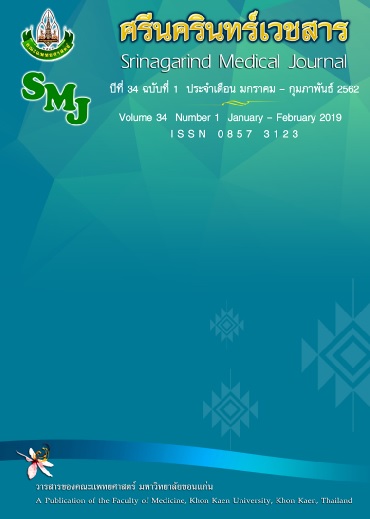การมีส่วนร่วมของครอบครัวและชุมชนในการดูแลผู้ป่วยจิตเภทเรื้อรัง: กรณีศึกษาที่ชุมชนบ้านท่าม่วง จังหวัด ร้อยเอ็ด
คำสำคัญ:
Schizophrenia patient; participation of communityบทคัดย่อ
หลักการและวัตถุประสงค์ : การมีส่วนร่วมของครอบครัวและชุมชนในการดูแลผู้ป่วยจิตเภทเรื้อรัง มีประโยชน์ต่อทั้งผู้ป่วยจิตเภท ครอบครัว ชุมชนและพยาบาล การวิจัยเชิงปฏิบัติการแบบมีส่วนร่วมนี้ มีวัตถุประสงค์เพื่อ 1) ศึกษาการมีส่วนร่วมของชุมชนในการดูแลผู้ป่วยจิตเภทเรื้อรัง 2) ศึกษาผลของโปรแกรมการสนับสนุนครอบครัวต่ออาการทางลบของผู้ป่วยจิตเภท
วิธีการศึกษา : การวิจัยเชิงปฏิบัติการแบบมีส่วนร่วมครั้งนี้ทำการ คัดเลือกกลุ่มผู้เข้าร่วมแบบเฉพาะเจาะจง จำนวน 38 ราย ประกอบด้วยสมาชิกครอบครัวของผู้ป่วยจิตเภท 12 ราย ผู้ป่วยจิตเภท 12 ราย พยาบาลวิชาชีพ 2ราย และอาสาสมัครสาธารณสุข 12 ราย เครื่องมือที่ใช้ประกอบด้วย แบบสอบถามข้อมูลทั่วไป การสนทนากลุ่ม และการสัมภาษณ์เชิงลึก แบบประเมินอาการทางลบ เก็บข้อมูลโดยใช้กระบวนการ PAR ประกอบด้วย 1) ระยะวางแผนการสร้างกระบวนการมีส่วนร่วมของชุมชน 2) ระยะดำเนินการ 3) ระยะกำกับติดตามกระบวนการมีส่วนร่วมของชุมชน และ 4) ระยะประเมินผล วิเคราะห์ข้อมูลเชิงปริมาณและข้อมูลเชิงคุณภาพใช้การวิเคราะห์เชิงเนื้อหา
ผลการศึกษา : กระบวนการวิจัยเชิงปฏิบัติการแบบมีส่วนร่วมโดยใช้แกนนำในชุมชน เป็นการนำทรัพยากรจากชุมชนมาพัฒนาศักยภาพชุมชน ให้สามารถคิด วิเคราะห์ วางแผน ดำเนินการ และติดตามประเมินผลในและการใช้โปรแกรมสนับสนุนครอบครัว อาการทางลบของผู้ป่วยจิตเภท หลังได้รับโปรแกรมการสนับสนุนกลุ่มครอบครัว น้อยกว่าก่อนได้รับโปรแกรมการสนับสนุนกลุ่มครอบครัว อย่างมีนัยสำคัญทางสถิติ (p<.05)
สรุป : กระบวนการมีส่วนร่วมของชุมชนในการดูแลผู้ป่วยจิตเภทเรื้อรัง โดยการร่วมคิด วิเคราะห์ วางแผน ดำเนินการ และติดตามประเมินผล สามารถช่วยฟื้นฟูให้ผู้ป่วยจิตเภทสามารถช่วยเหลือตนเองได้ตามอัตภาพ และโปรแกรมสนับสนุนครอบครัวสามารถลดอาการทางลบและทำให้ผู้ป่วยจิตเภทอยู่ร่วมกับครอบครัวได้
เอกสารอ้างอิง
2. Mc Grath J, Saha S, Chant D, Welham J. Schizophrenia: A Concise Overview of Incidence, Prevalence, and Mortality. Epidemiologic Rev. 2008; 30: 67-76.
3. Phanthunane P, Vos T, Whiteford H, Bertram M, Udomratn P. Schizophrenia in Thailand: prevalence and burden of disease. Popul Health Metr. 2010;24: 1-8.
4. Sadock, B.J., Sadock, V.A. Kaplan & Sadock’s synopsis of psychiatry: Behavioral Sciences and clinical psychiatry.10thed. Philadelphia: Williams & Wilkins. New York; 2007.
5. กรมสุขภาพจิต กระทรวงสาธารณสุข. รายงานสถิติผู้ป่วยนอกของโรงพยาบาลจิตเวช. ประเทศไทย. 2549
6.พิชญา เหลียงพานิช, ชมชื่น สมประเสริฐ, เอกอุมา อิ้มคำ. ผลของโปรแกรมกลุ่มเพื่อนช่วยเพื่อนต่อความสามารถในการฟื้นฟูจิตสังคมผู้ป่วยจิตเภทของผู้ดูแล. วารสารพยาบาลทหารบก. 2560; 3: 357-64.
7. Knapp Martin, Mc Crone P, Leeuwenkamp Oscar. Associations between negative symptoms, service use patterns, and costs in patients with schizophrenia in the five European countries. Clinical Neuropsychiatry. 2008; 5: 195-205.
8. Carpenter WT Jr, Heinrichs DW, Alphs LD. Treatment of negative symptoms. Schizophr Bull. 1985; 11: 440-52.
9. Carpenter WT Jr, Strauss JS, Bartko JJ. Flexible system for the diagnosis of schizophrenia: Report from WHO International Pilot Study of Schizophrenia. Science. 197; 182: 1275-8.
10. ธนา นิลชัยโกวิทย์, เปญ อุ่นอนงค์, ดารเณศ เกษไสว, ปราการ ถมยางกูร. Positive and negative syndrome scale ฉบับภาษาไทย (PANSS-T). กรุงเทพฯ: แจนแซ่นแลก, 2550.
11. อติญา โพธิ์ศรี, เพ็ญพักตร์ อุทิศ. ผลของโปรแกรมการสนับสนุนกลุ่มครอบครัวต่ออาการทางลบของผู้ป่วยจิตเภทชุมชน. วารสารพยาบาลสภาการชาดไทย. 2551, 1(1): 68-85
12. ปราณี มีหาญพงษ์, กรรณิการณ์ ฉัตรดอกไม้. การตรวจสอบคุณภาพของเครื่องมือวิจัยทางการพยาบาล.วารสารพยาบาลทหารบก. 2561,1: 9-15.
13. ศิริพร จิรวัฒน์กุล. การวิจัยเชิงคุณภาพในวิชาชีพพยาบาล(พิมพ์ครั้งที่ 2). ขอนแก่น: คณะพยาบาลศาสตร์ มหาวิทยาลัยขอนแก่น, 2548.
14. แก้วตา มีศรี, เพ็ญนภา แดงด้อมยุทธ์. ปัจจัยที่มีความสัมพันธ์กับความสามารถของผู้ดูแลผู้ป่วยจิตเวชในชุมชน. วารสารพยาบาลสุขภาพจิตและจิตเวช. 2555; 26: 35-49.
15. เปรมฤดี ดำรักษ์, อังคณา วังทอง, อนุชิต วังทอง. การมีส่วนร่วมของชุมชนในการดูแลผู้ป่วยจิตเภทเรื้อรังซับซ้อน อำเภอหนองจิก จังหวัดปัตตานี. วารสารสมาคมนักวิจัย. 2557; 19: 92-103.
16. ขวัญสุดา บุญทศ, อมรรัตน์ ศรีคำสุข ไซโตะ, สุวรรณา อรุณพงค์ไพศาล. การสนับสนุนทางสังคมต่อผู้ที่เป็นโรคจิตเภท. การประชุมวิชาการ ครั้งที่ 27 ประจำปี 2554.
17. ขุมทรัพย์ ก้อน, ทองวีณา จีระแพทย์, เพ็ญพักตร์ อุทิศ. ผลของโปรแกรมการบำบัดทางความคิดและพฤติกรรมต่ออาการด้านลบของผู้ป่วยจิตเภทในชุมชน. วารสารการพยาบาลสุขภาพและจิตเวช. 2559; 30: 52-65.




